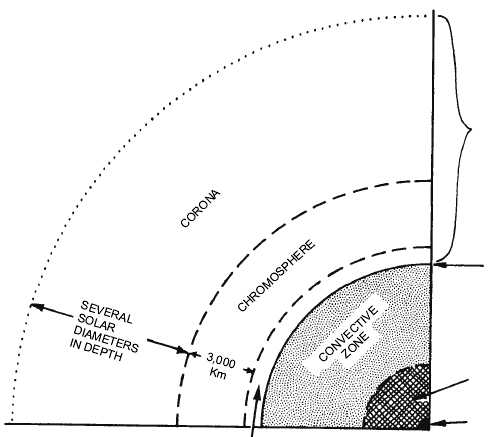Solar Composition
The Sun may be described as a globe of gas heated
to incandescence by thermonuclear reactions from
within the central core.
The main body of the Sun, although composed of
gases, is opaque and has several distinct layers. (See fig.
1-1.) The first of these layers beyond the radiative zone
is the convective zone. This zone extends very nearly to
the Sun’s surface. Here, heated gases are raised
buoyantly upwards with some cooling occurring and
subsequent convective action similar to that, which
occurs within Earth’s atmosphere. The next layer is a
well-defined visible surface layer referred to as the
photosphere. The bottom of the photosphere is the solar
surface. In this layer the temperature has cooled to a
surface temperature of 6,000°K at the bottom to
4,300°K at the top of the layer. All the light and heat of
the Sun is radiated from the photosphere. Above the
photosphere is a more transparent gaseous layer
referred to as the chromosphere with a thickness of
about 1,800 miles (3,000 km). It is hotter than the
photosphere. Above the chromosphere is the corona, a
low-density high temperature region. It is extended far
out into interplanetary space by the solar wind—a
steady outward streaming of the coronal material.
Much of the electromagnetic radiation emissions
consisting of gamma rays through x-rays, ultraviolet,
visible and radio waves, originate in the corona.
Within the solar atmosphere we see the occurrence
of transient phenomena (referred to as solar activity),
just as cyclones, frontal systems, and thunderstorms
occur within the atmosphere of Earth. This solar
activity may consist of the phenomena discussed in the
following paragraphs that collectively describe the
features of the solar disk (the visual image of the outer
1-3
PHOTOSPHERE
RADIATIVE ZONE
SOLAR
ATMOSPHERE
SOLAR SURFACE
TEMPERATURE
APPROX. 6,000 K
O
CENTRAL CORE
(THERMONUCLEAR
REACTIONS) APPROX.
15,000,000 K
O
AGf0101
Figure 1-1.—One-quarter cross-section depicting the solar structure.


